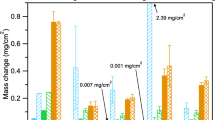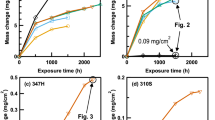Abstract
The alloys being used in high-temperature systems such as stationary gas turbines and aircraft engines are iron-, cobalt- and nickel-based superalloys, amongst which the latter is the most widely used for highest temperatures. However, the use of Ni-based alloys is limited to temperatures below 1,100 °C. The experimental Co–Re-based alloys are promising for high-temperature applications for service temperatures beyond 1,200 °C. The purpose of the present investigations, at this still early stage of the alloy development, is to gain a first insight into the oxidation mechanisms and to find ways to improve oxidation resistance of this class of materials. Thermogravimetric studies in combination with microstructural examinations of six model Co–Re alloys with different compositions showed the negative influence of rhenium on the oxidation resistance of Co-based alloys due to evaporation of rhenium oxide(s). Oxidation at 1,000 °C in air yielded an oxide scale, that consists of a Co-oxide outer layer on a thick and porous Co–Cr oxide and a semicontinuous and therefore non-protective Cr-oxide film on the base metal substrate. This allowed for the vaporization of rhenium oxide formed during oxidation and hence led to a loss of Re. Computer-aided thermodynamic calculations were carried out to supplement the experimental analyses and were found to reasonably predict the stability ranges of the various oxide phases observed.














Similar content being viewed by others
References
C. R. Brooks, Heat Treatment, Structure and Properties of Nonferrous Alloys (American Society for Metals, Ohio, 1984).
J. Rösler, D. Mukherji, and T. Baranski, Advanved Engineering Materials 9, 876 (2007).
P. C. Sullivan, M. J. Donachie, and F. R. Morral, Cobalt-Base Superalloy-1970, Cobalt Monograph Series (Cobalt Information Center, Brussels, 1970).
G. E. Andre, R. Breckpot, L. Habraken, J. C. Jungers, P. Kipfer, G. V. JRaynor, and H. Schuiling, Cobalt Monograph (Cobalt Information Center, Brussels, 1960).
R. Bürgel, Hochtemperaturwerkstofftechnik (Vieweg, Braunschweig, 2001).
P. S. Liu and K. M. Liang, Oxidation of Metals 53, 351 (2000).
P. S. Liu, K. M. Liang, H. Y. Zhou, H. R. Guan, X. F. Sun, T. Jin, and K. N. Yang, Oxidation of Metals 55, 543 (2000).
W. Betteridge, Cobalt and its Alloys (Ellis Horwood Ltd., Chichester, 1982).
P. C. Patnaik, High Temperature Oxidation and Hot Corrosion of Nickel and Cobalt Based Superalloys, Aeronautical Note NAE-AN-33 NRC No. 25075 (Ottawa, 1985).
R. L. Dreshfield, J. C. Freche, and G. D. Sandrock, Modification of High-Temperature Cobalt-Tungsten Alloys for Improved Stability, Report NASA TN D-6147 (Ohio, 1971).
T. C. Chou, A. Joshi, and C. M. Packer, Scripta Metallurgica et Materialia 28, 1565 (1993).
B. D. Bryskin, Advanced Materials & Processes 10, 83 (1998).
Y. N. Gornostyrev, M. I. Katsnel’son, A. V. Trefilov, and R. F. Sabiryanov, The Physics of Metals and Metallography 74, 421 (1992).
B. D. Bryskin, Heat Treating 6, 10 (1993).
L. Huang, X. F. Sun, H. R. Guang, and Z. Q. Hu, Surface & Coatings Technology 200, 6863 (2006).
C. T. Liu, X. F. Sun, H. R. Guang, and Z. Q. Hu, Surface & Coatings Technology 197, 39 (2005).
K. B. Lebedev, The Chemistry of Rhenium (Butterworths, London, 1962).
M. Klauke, D. Mukherji, B. Gorr, J. Rösler, and H.-J. Christ, International Journal of Materials Research, 100, 1 (2009).
V. B. Trindade, Hochtemperaturoxidation Chromlegierter Stähle und von Nickel-Basislegierungen: Experimentelle Untersuchung und Computersimulation, Ph.D. thesis (Shaker Verlag, Aachen, 2005).
C. K. Kim and L. W. Hobbs, Oxidation of Metals 47, 69 (1997).
P. Kofstad, High Temperature Corrosion (Elsevier Applied Science, London, 1988).
P. Kofstad, Oxidation of Metals 24, 265 (1985).
F. H. Stott, Oxidation of Metals 11, 141 (1977).
B. A. Pint, Oxidation of Metals 39, 167 (1933).
K. P. Lillerud and P. Kofstad, Oxidation of Metals 17, 127 (1982).
Acknowledgements
This study has been supported by Deutsche Forschungsgemeinschaft in the framework of the DFG research group “Beyond Ni-base Superalloys”
Author information
Authors and Affiliations
Corresponding author
Rights and permissions
About this article
Cite this article
Gorr, B., Trindade, V., Burk, S. et al. Oxidation Behaviour of Model Cobalt-Rhenium Alloys During Short-Term Exposure to Laboratory Air at Elevated Temperature. Oxid Met 71, 157–172 (2009). https://doi.org/10.1007/s11085-008-9133-y
Received:
Revised:
Published:
Issue Date:
DOI: https://doi.org/10.1007/s11085-008-9133-y




